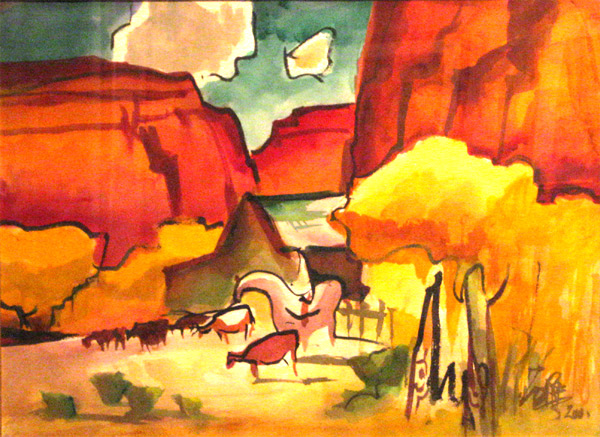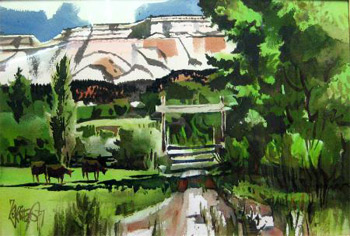LeConte Stewart: Depression Era Art
 Saturday, July 16, 2011 at 10:45PM Tweet
Saturday, July 16, 2011 at 10:45PM Tweet LeConte Stewart: Depression Era Art
at the Utah Museum of Fine Arts, Salt Lake City, Utah - 21 July 2011 through 15 January 2012
By Donna Poulton
Best known for the Red Rock splendors of Monument Valley and of Zion and Bryce Canyons, southern Utah has long attracted artists from around the world.
 LeConte Stewart, “Postmaster General” Credit: Church History Museum
LeConte Stewart, “Postmaster General” Credit: Church History Museum
Although LeConte Stewart (1891-1990) grew up near these iconic sites, it was actually Utah’s small towns, farms, and urban landscapes that captured his imagination from a very young age.
 LeCone Stewart, “House by the Railroad” Credit: Private Collector
LeCone Stewart, “House by the Railroad” Credit: Private Collector
In a career spanning more than 75 years, Stewart created images of Utah that are simultaneously epic and intimate. He was talented at etching, lithography, and lettering, yet it is his oil paintings that have garnered the widest recognition among both collectors and museum visitors.
 LeConte Stewart, “Private Car” Credit: Church History Museum
LeConte Stewart, “Private Car” Credit: Church History Museum
Looking back, Stewart noted that three themes dominated his landscape paintings of Utah. The first was the desert: like most Westerners, he was attracted to sage-covered plateaus and hills — scenes of endless expanse.
 LeConte Stewart, “Cannery” Credit: Private Collection
LeConte Stewart, “Cannery” Credit: Private Collection
 LeConte Stewart, “The Victorian” Credit: Utah Museum of Fine Arts
LeConte Stewart, “The Victorian” Credit: Utah Museum of Fine Arts
The second theme was the scenic region that hugs the foothills of the Wasatch Mountains: wide meadows with cottonwood trees and Lombardy poplars are punctuated with such humanizing elements as barns, corrals, farmhouses, and winding lanes.
 LeConte Stewart, “Home Loan” Credit: Jan and Paul Doxey
LeConte Stewart, “Home Loan” Credit: Jan and Paul Doxey
The third theme emerged during the 15-year period when Stewart explored the effects of the Great Depression — urban and rural landscapes of trains, stores, factories, homes, and men at work in the fields.
 LeConte Stewart, “Toe Hold” Credit: Springville Museum of Art
LeConte Stewart, “Toe Hold” Credit: Springville Museum of Art
This is the largest collection of LeConte Stewart’s extraordinary work ever exhibited. Not to be missed.
 LeConte Stewart, “The Smith’s” Credit: Utah Museum of Fine Arts
LeConte Stewart, “The Smith’s” Credit: Utah Museum of Fine Arts
 LeConte Stewart, “Untitled” Credit: Private Collection
LeConte Stewart, “Untitled” Credit: Private Collection
 LeConte Stewart, “Death Curve” Credit: Private Collection
LeConte Stewart, “Death Curve” Credit: Private Collection
 LeConte Stewart, “Finale” Credit: Catherine and Gibbs Smith
LeConte Stewart, “Finale” Credit: Catherine and Gibbs Smith















